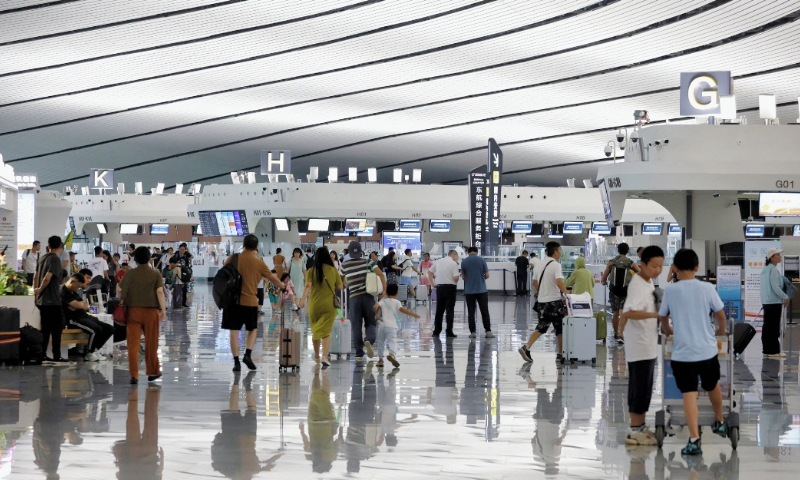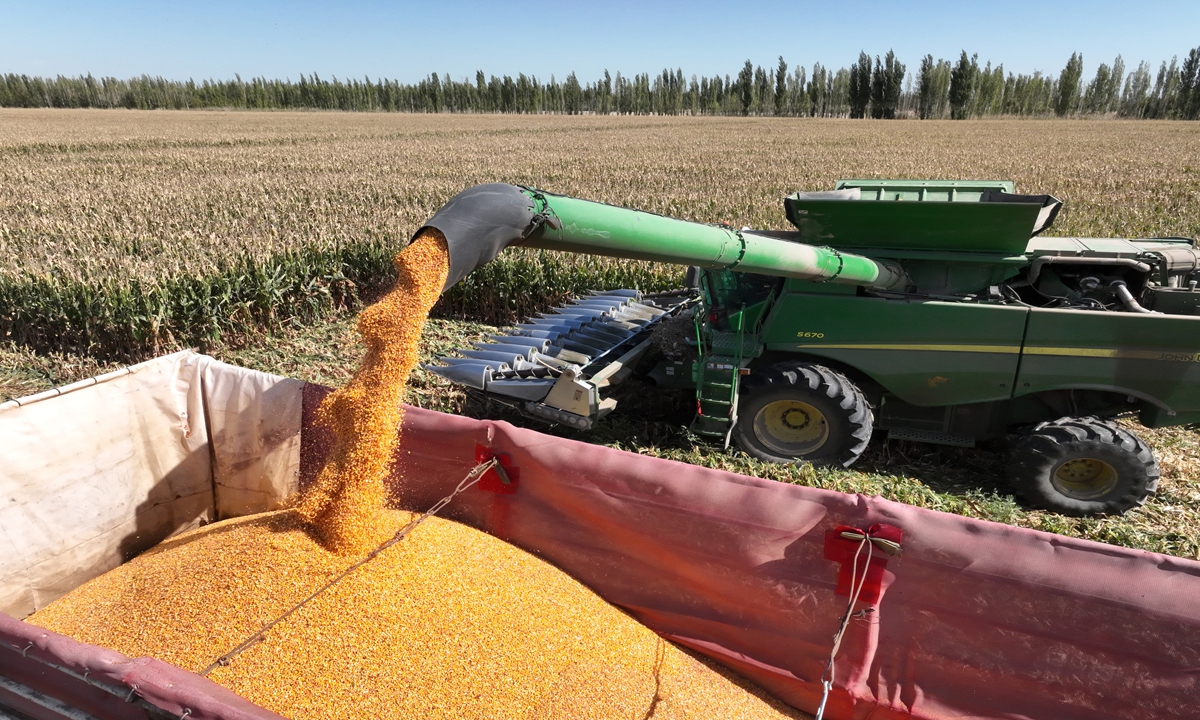Xinjiang becomes a gateway for westward opening-up with surging agricultural produce and vehicle exports

Transport trucks loaded with made-in-China cars wait for customs clearance at the Khorgos Port in Northwest China's Xinjiang Uygur Autonomous Region on November 7, 2023. Photo: VCG
As trains and trucks line up to run across various ports in Northwest China's Xinjiang Uygur Autonomous Region, the region is transforming from a relatively closed inland area to becoming the forefront of China's westward opening-up.
Amid the soaring foreign trade in the region, vehicle and agricultural produce exports have emerged as new highlights, the Global Times learned while visiting the ports.
From January to September this year, the Khorgos Port recorded surging export of 195,000 vehicles, marking a remarkable year-on-year growth of 308.2 percent, Chen Pengde, deputy head of Khorgos Customs, told the Global Times.
Among the vehicles, 69,000 were exported via road, showing a substantial increase of 180.7 percent, while export via rails reached 126,000 vehicles, witnessing a staggering growth of 441 percent. Khorgos has become the largest land port for automobile export in China, Chen said.
A total of 100,000 vehicles were exported to date this year in Xinjiang, according to data provided by Khorgos Port, surpassing last year's export of 42,000 units.
"We expect the figure to reach 120,000 units by the end of this year, accounting for 5 percent of China's total auto export," Hu Laijie, a senior official of the Khorgos Port Administration, told the Global Times.
Booming export of vehicles
Another major port in Xinjiang also recorded a massive increase in exported vehicles. From January to September, Alashankou Port exported 82,000 vehicles, up 694.5 percent year-on-year. Among them, 81,000 units were exported by rail, an increase of 710.8 percent year-on-year, and 1,000 vehicles were shipped by trucks, up 175.8 percent.
Starting from January this year, Dulata Port has facilitated over 2,000 vehicle exports, according to Dulata Customs.
"The port is drawing more auto export business, and we expect to increase our vehicle exports to 20,000 - 30,000 units in the years to come," Guan Cuiying, a senior official from Dulata port, told the Global Times.
China has witnessed a robust upswing in auto exports to Central Asian markets, with Uzbekistan and Kyrgyzstan emerging as new growth points for Chinese auto exports, Cui Dongshu, secretary general of China Passenger Car Association, told the Global Times on Thursday.
Citing data in the first nine months, Cui noted that there was a notable increase in exports to markets including Russia, Central Asia, North America and Asia.
From January to September, China exported a total of 3.71 million automobiles, maintaining a strong growth of 60 percent, said Cui.
Automobile export isn't the only category witnessing robust growing in Xinjiang. Agricultural produce and food have seen strong growth in both imports and exports.
Top cargo throughput
For the seventh consecutive year, Khorgos Port has maintained its position as the top cargo throughput port in the entire Xinjiang region. In the first three quarters, the port's cargo throughput reached 31.08 million tons, data provided by the port showed.
Notably, there was a significant increase in imports of agricultural produce, with agricultural trade volume growing by 148.3 percent, compared to the same period last year, Chen said.
Khorgos Customs supervised the import of 262,000 tons of grain from Central Asia, marking a 2.5-fold year-on-year increase. From January to September, Khorgos Port exported 66,000 tons of fruits and vegetables, reflecting a substantial growth of 69 percent. Major fruit exports include peaches, apples, and pears, according to Chen.
Major ports in Xinjiang have opened a fast customs clearance channel for agricultural produce. In 2022, Xinjiang's agricultural exports reached 6.83 billion yuan ($943 million), surging 37.2 percent year-on-year, according to media reports.
The significant temperature differences between day and night and abundant sunshine in Xinjiang create ideal natural conditions for high-quality agricultural produce. Premium products such as walnuts, fragrant pears, and apples are highly favored by domestic and international markets.
In the meantime, situated in the heartland of the Eurasian continent, Xinjiang holds the distinction of being the region with the largest number of land ports in China. It plays an irreplaceable role and holds a crucial position in the construction of the Silk Road Economic Belt, contributing significantly to the development of the economic corridor.
Forefront of Opening-up
As for agricultural produce, Xinjiang's strategic geographical advantage of bordering eight countries provides favorable market conditions for highly perishable agricultural products, offering short transportation distances and low costs.
Xinjiang has become a hub for rail transportation as well. Currently, there are 112 routes of China-Europe Freight Trains passing through the Alashankou Port, connecting with 21 countries. Additionally, through the Khorgos Port, there are 80 freight train routes, radiating to 18 countries, 45 cities and regions, according to media reports.
With 18 ports linking to the global market, Xinjiang is leveraging its unique position to shore up cluster industries. Per Urumqi customs data, Xinjiang's ports accumulated a total import and export value of 779.12 billion yuan in the first 10 months of the year, marking a year-on-year increase of 24.3 percent and achieving a historical high for the same period.
In order to advance the development of the "port economy," Xinjiang has been strengthening the synergistic development of key ports with national-level platforms such as comprehensive bonded zones and cross-border e-commerce pilot zones. Currently, leveraging these key ports, Xinjiang has established four comprehensive bonded zones, which will further drive the rapid growth of across-border trade.
Efforts are underway to transform Xinjiang into a key gateway for the Asia-Europe "golden corridor" and a strategic forefront for China's westward opening-up.



